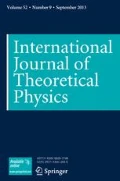Abstract
Bohmian mechanics is a quantum theory with a clear ontology. To make clear what we mean by this, we shall proceed by recalling first what are the problems of quantum mechanics. We shall then briefly sketch the basics of Bohmian mechanics and indicate how Bohmian mechanics solves these problems and clarifies the status and the role of the quantum formalism.
Similar content being viewed by others
REFERENCES
Allori, V. (2001). Decoherence and the Classical Limit of Quantum Mechanics, PhD Thesis, Diparti-mento di Fisica dell'Università di Genova.
Allori, V., Dürr, D., Goldstein, S., and Zanghìý, N. (2002). Seven steps towards the classical world. Journal of Optics B 4, 482-488.
Allori, V. and Zanghìý, N. (2004). On the classical limit of quantum mechanics. International Journal of Theoretical Physics 43, 1743-1755.
Aspect, A., Grangier, P., and Roger, G. (1981). Experimental test of realistic local theories via Bell's theorem. Physical Review Letters 47, 460-463.
Bell, J. S. (1987). Speakable and Unspeakable in Quantum Mechanics, Cambridge University Press, Cambridge, UK.
Berndl, K., Dürr, D., Goldstein, S., Peruzzi, G., and Zanghìý, N. (1995). On the global existence of Bohmian mechanics. Communications in Mathematical Physics 173, 647-673.
Berndl, K., Dürr, D., Goldstein S., and Zanghìý, (1996). Nonlocality, Lorentz invariance, and Bohmian quantum theory. Physical Review A 53, 2062-2073.
Bohm, D. (1952). Asuggested interpretation in terms of “Hidden Variables”: Part I and Part II. Physical Review 85, 166-179 and 180-193, reprinted in Wheeler and Zurek, op. cit.
Bohm, D. and Hiley, B. J. (1993). The Undivided Universe, Routledge and Kegan Paul, London.
Bricmont, J. (2001). Bayes, Boltzmann and Bohm: Probabilities in physics. In Chance in Physics, Springer, J. Bricmont, D. Dürr, G. Ghirardi, F. Petruccione, and N. Zanghìý, eds., Lecture Notes in Physics 574,3-21.
Daumer, M., Dìrr, D., Goldstein, S., and Zanghìý, N. (1997a). On the quantum probability flux through surfaces, Journal of Statistical Physics 88, 967-977.
Daumer, M., Dìrr, D., Goldstein, S., and Zanghìý, N. (1997b). Naive realism about operators, Erkenntnis 45, 379-397.
Dìrr, D. (2001). Bohmsche Mechanik als Grundlage der Quantenmechanik, Springer-Verlag, Berlin.
Dìrr, D., Goldstein, S., Teufel, S., and Zanghìý, N. (2000). Scattering theory from microscopic first principles, Physica A 279, 416-431.
Dìrr, D., Goldstein, S., and Zanghìý, N. (1992). Quantum equilibrium and the origin of absolute uncer-tainty. Journal of Statistical Physics 67, 843-907.
Dìrr, D., Goldstein, S., and Zanghìý, N. (1996). Bohmian mechanics as the foundation of quantum mechanics. In Bohmian Mechanics and Quantum Theory: An Appraisal, Kluwer Academic, J. T. Cushing, A. Fine, and S. Goldstein, eds., Boston Studies in the Philosophy of Science 184,21-44.
Dìrr, D., Goldstein, S., and Zanghìý, N. (2004). Quantum equilibrium and the role of operators as observables in quantum theory. Journal of Statistical Physics 116, 959-1055.
Dìrr, D., Mìnch-Berndl, K., Goldstein, S., and Zanghì (1999). Hypersurface Bohm-Dirac models Physical Review A 60, 2729-2736.
Einstein, A., Podolsky, B., and Rosen, N. (1935). Can quantum mechanical description of reality be considered complete? Physical Review 47, 777-780, reprinted in Wheeler and Zurek, op. cit.
Ghirardi, G. C., Rimini, A., and Weber, T. (1986). Unified dynamics for microscopic and macroscopic systems, Physical Review D 34, 470-491.
Gleason, A. M. (1957). Measures on the closed subspaces of a Hilbert space. Journal of Mathematics and Mechanics 6, 885-893.
Goldstein, S. (1998). Quantum theories without observers. Physics Today 51, 3,42-47 and 4, 38-42.
Goldstein, S. (2001). Bohmian mechanics In Stanford Encyclopedia of Philosophy, http://plato.stanford.edu/entries/qm-bohm.
Goldstein, S. and Tumulka, R. (2003). Opposite arrows of time can reconcile relativity and nonlocality. Classical and Quantum Gravity 20, 557-564.
Holland, P. R. (1993). The Quantum Theory of Motion, Cambridge University Press, Cambridge, UK.
Kochen, S. and Specher, E. P. (1967). The problem of hidden variables in quantum mechanics. Journal of Mathematics and Mechanics 17,59-87.
Leavens, C. R. (1996). The tunneling-time problem for electrons. In Bohmian Mechanics and Quantum Theory: An Appraisal, Kluwer Academic, J. T. Cushing, A. Fine, and S. Goldstein, eds., Boston Studies in the Philosophy of Science 184, 111-120.
Schrödinger, E. (1935). Die Gegenvärtige Situation in der Quantenmechanik. Naturwissenschaften 23, 807-812, english translation by J. D. Trimmer: The Present Situation in Quantum Me-chanics: A Traslation of Schrödinger's “Cat Paradox” Paper, reprinted in Wheeler and Zurek,op. cit.
Solvay Congress (1928). Electron et photons: Rapport et Discussion du Cinquienne Conseil de Physique tenu a Bruxelles du 24 au 29 Octobre 1927 sous les auspices de l'Institut International de Physique Solvay Gauthier Villars, Paris.
von Neumann, J. (1932). Mathematische Grundlagen der Quantenmechanik, Springer Verlag, Berlin, English translation by R. T. Beyer (1955). Mathematical Foundations of Quantum Mechanics, Princeton University Press, Princeton, NJ.
Wheeler, J. A. and Zurek, W. H. (1983). Quantum Theory and Measurement, Princeton University Press, Princeton, NJ.
Author information
Authors and Affiliations
Rights and permissions
About this article
Cite this article
Allori, V., Zanghì, N. What Is Bohmian Mechanics. International Journal of Theoretical Physics 43, 1743–1755 (2004). https://doi.org/10.1023/B:IJTP.0000048817.79384.2a
Issue Date:
DOI: https://doi.org/10.1023/B:IJTP.0000048817.79384.2a




